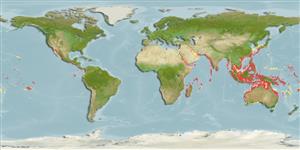Common names from other countries
Environment: milieu / climate zone / depth range / distribution range
Ecología
; rango de profundidad 0 - 50 m (Ref. 96667). Tropical
Distribución
Países | Áreas FAO | Ecosistemas | Ocurrencias, apariciones | Introducciones
Indo-Pacific: from South Africa to Southeast Asia and Tahiti.
Length at first maturity / Tamaño / Peso / Age
Maturity: Lm ? range ? - ? cm Max length : 7.0 cm CW macho / no sexado; (Ref. 343)
Shows distinctive broad blue and white bands on the legs when alive.
Occurs from the intertidal zone to a depth of about 20 m. Prefers rocky areas and reefs (Ref. 343) and muddy bottoms (Ref. 106287).
Life cycle and mating behavior
Madurez | Reproducción | Puesta | Huevos | Fecundidad | Larva
Members of the order Decapoda are mostly gonochoric. Mating behavior: Precopulatory courtship ritual is common (through olfactory and tactile cues); usually indirect sperm transfer.
Ng, P.K.L. 1998. (Ref. 343)
IUCN Red List Status (Ref. 130435)
CITES status (Ref. 108899)
Not Evaluated
Not Evaluated
Threat to humans
Harmless
Human uses
| FishSource |
Herramientas
Fuentes de Internet
Estimates based on models
Preferred temperature
(Ref.
115969): 24.5 - 29.1, mean 28 (based on 1490 cells).
Vulnerability
Low vulnerability (10 of 100).
Price category
Unknown.
